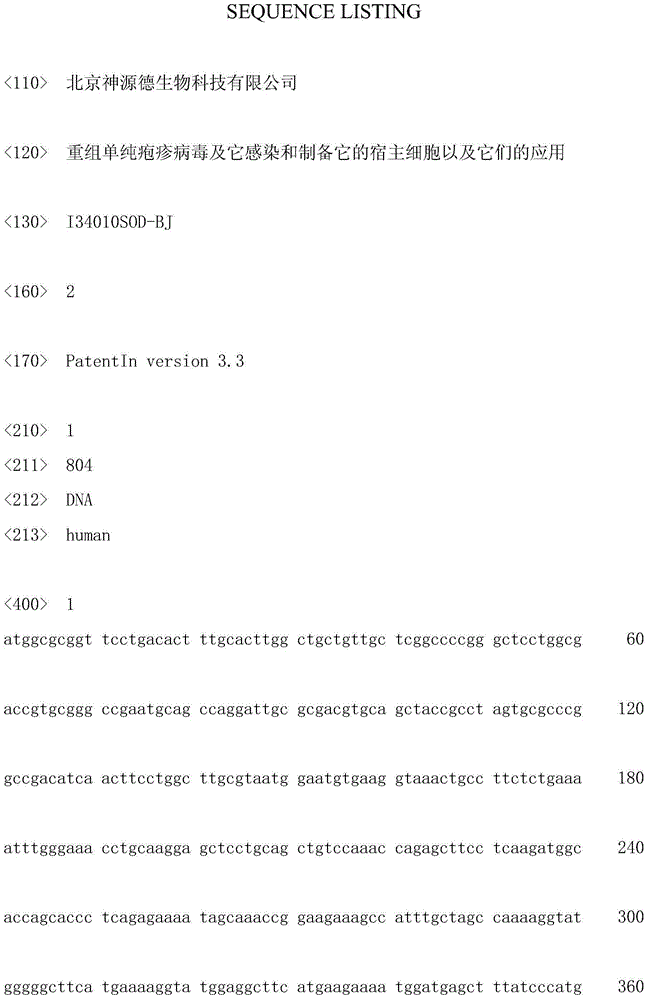Recombinant herpes simplex virus, host cell infected with recombinant herpes simplex virus, host cell for preparation of recombinant herpes simplex virus and their applications
A herpes simplex virus and cell-infecting technology, which is applied to cells modified by introducing foreign genetic material, virus/bacteriophage, and drug combinations, etc., can solve the problems of cross-contamination, immunogenicity, and differences in efficacy of mouse-derived viruses. , to avoid dependence and related side effects, long duration of treatment, and avoid drug diffusion
- Summary
- Abstract
- Description
- Claims
- Application Information
AI Technical Summary
Problems solved by technology
Method used
Image
Examples
Embodiment approach
[0027] According to one embodiment of the present invention, the target gene can directly utilize the LAP1 and LAP2 promoters in the LAT region without adding a promoter.
[0028] According to the present invention, in order to ensure that the target gene can be effectively translated independently, the target gene of the present invention preferably also includes a promoter, a start codon and a stop codon. In such a preferred situation, the recombinant herpes simplex When a virus infects a host cell and expresses its own gene, it can transcribe an independent and complete target mRNA segment, thereby effectively and independently translating the target gene.
[0029]According to the present invention, the promoter can be various conventional promoters in the art. According to a preferred embodiment of the present invention, the insertion site of the target gene includes insertion into the latency-related transcription coding region of the herpes simplex virus vector, and when...
Embodiment 1
[0050] This example is used to illustrate the construction of the recombinant herpes simplex virus of the present invention
[0051] According to the application number 2004100064921, the method recorded in the patent application of the authorized announcement number CN1283803C will knock out the ICP34.5 gene and the ICP4 gene of the wild-type clinically isolated HSV-1 virus, and in the latent expression region (LAT region) of the HSV-1 vector The 119499bp-122025bp downstream of the promoter was inserted into the ENK gene carrying the CMV promoter. Sequencing at Beijing Sanbo Yuanzhi Company confirmed that the ENK gene was correctly inserted into the herpes simplex virus vector. The successfully constructed viral vector was incubated at 37°C, 5% CO on the constructed Vero host cell line capable of expressing the ICP4 gene. 2 The multiplication of infection was 0.1. After harvesting, the cell debris was removed with a 0.65 μm filter, and then purified by high-speed centrifugat...
Embodiment 2
[0053] This example is used to illustrate the construction of the recombinant herpes simplex virus of the present invention
[0054] The construction of the recombinant herpes simplex virus was carried out according to the method in Example 1, except that the genes knocked out were the ICP34.5, ICP27 and ICP4 genes of the HSV-1 virus.
PUM
| Property | Measurement | Unit |
|---|---|---|
| diameter | aaaaa | aaaaa |
| diameter | aaaaa | aaaaa |
Abstract
Description
Claims
Application Information
 Login to View More
Login to View More - R&D
- Intellectual Property
- Life Sciences
- Materials
- Tech Scout
- Unparalleled Data Quality
- Higher Quality Content
- 60% Fewer Hallucinations
Browse by: Latest US Patents, China's latest patents, Technical Efficacy Thesaurus, Application Domain, Technology Topic, Popular Technical Reports.
© 2025 PatSnap. All rights reserved.Legal|Privacy policy|Modern Slavery Act Transparency Statement|Sitemap|About US| Contact US: help@patsnap.com



